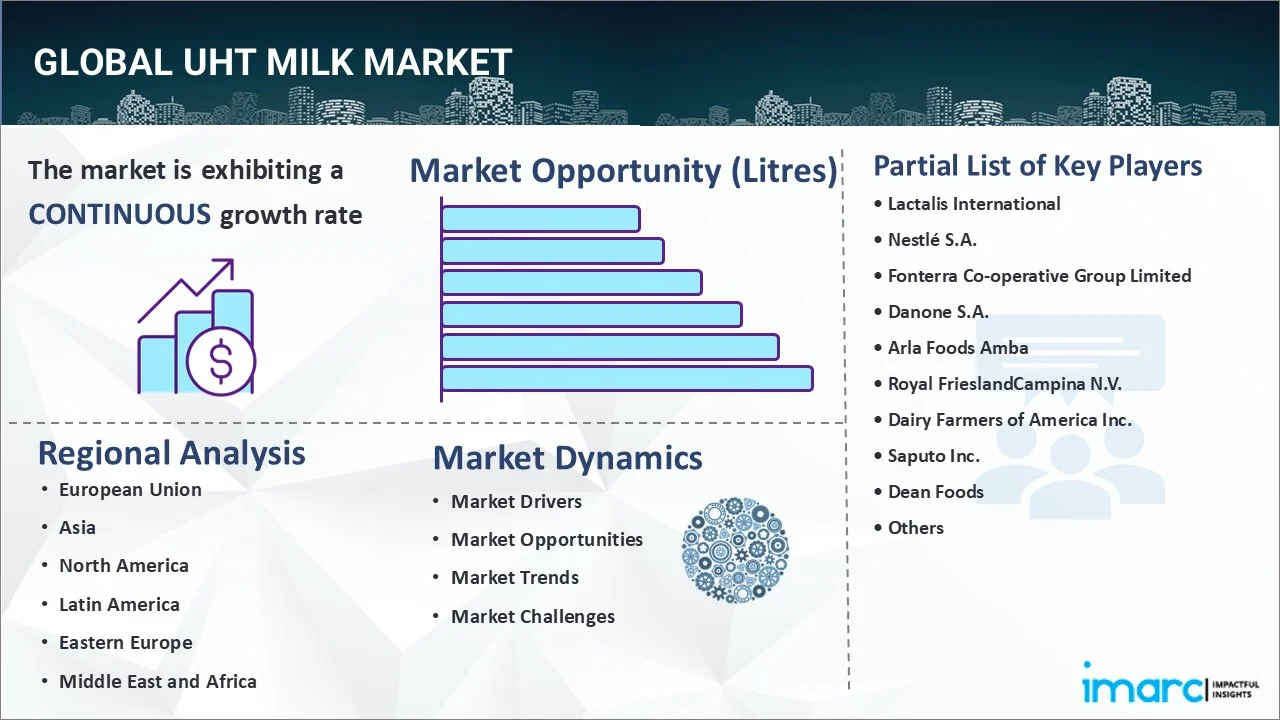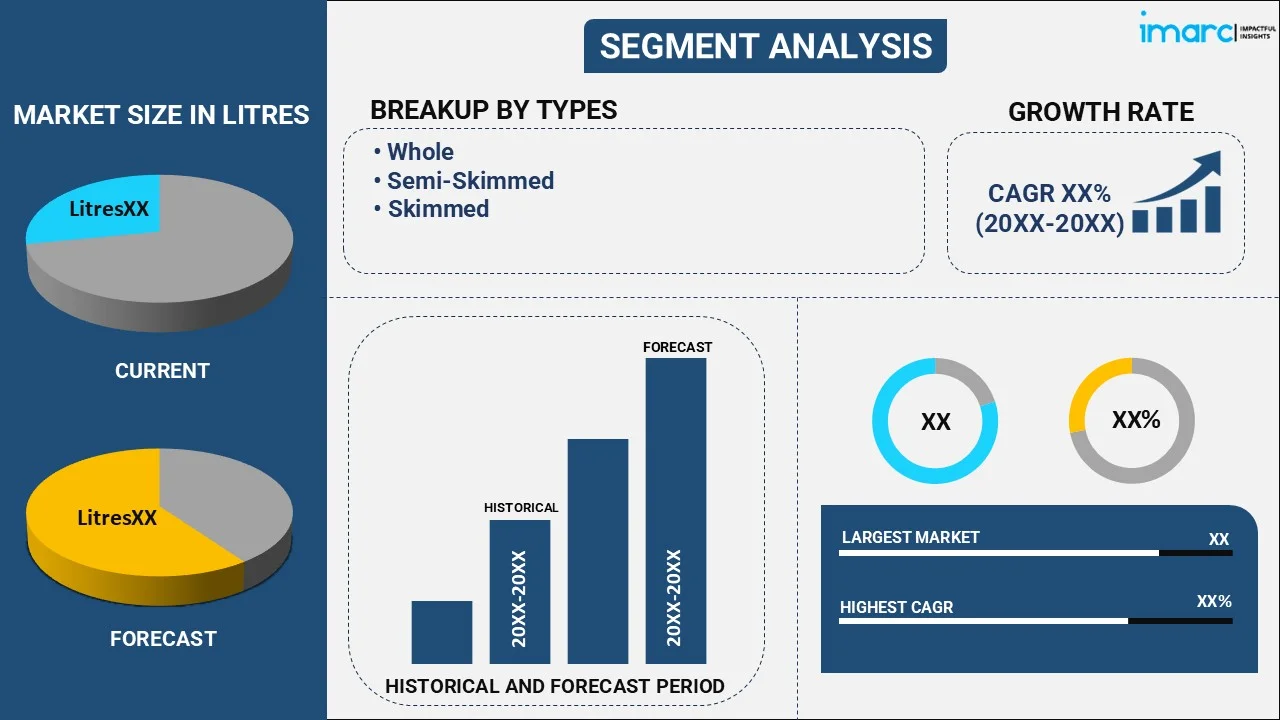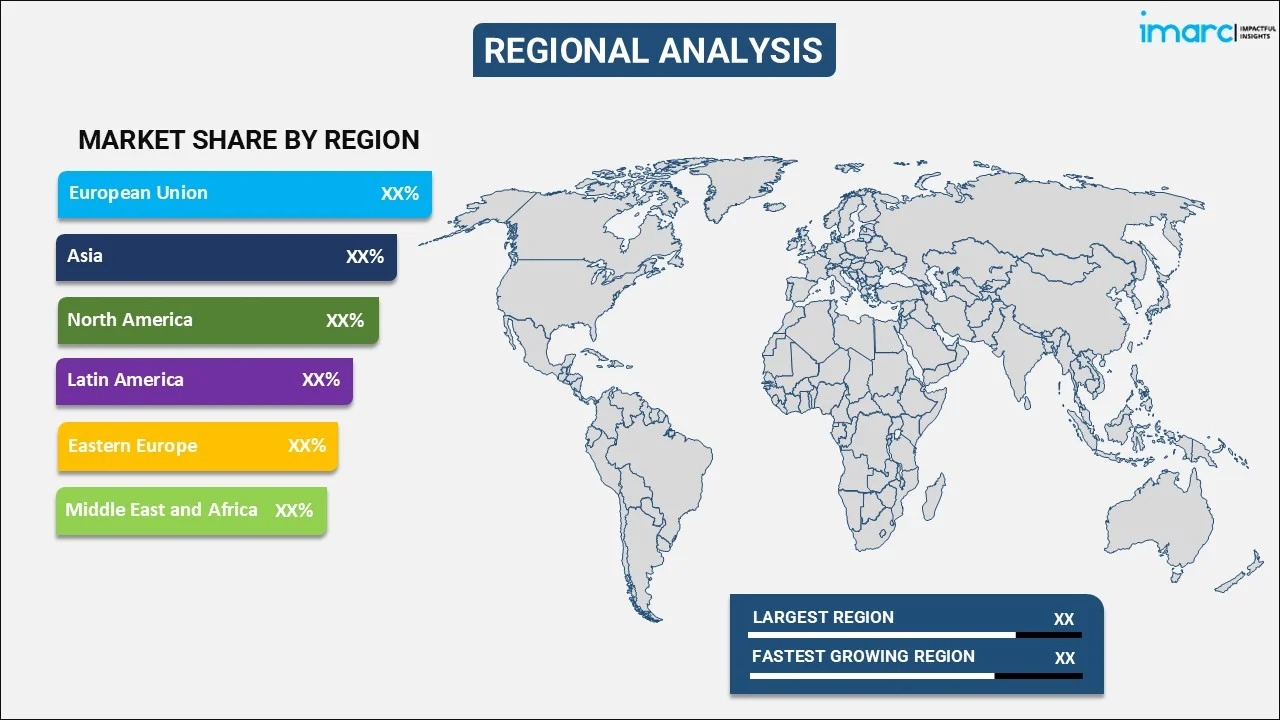
UHT Milk Market Report by Type (Whole, Semi-Skimmed, Skimmed), Distribution Channel (Supermarkets and Hypermarkets, Convenience Stores, Specialty Stores, Online Retail, and Others), and Region 2025-2033
UHT Milk Market Size and Share:
The global UHT milk market size reached 131.0 Billion Litres in 2024. Looking forward, IMARC Group expects the market to reach 205.4 Billion Litres by 2033, exhibiting a growth rate (CAGR) of 5.1% during 2025-2033. The rising demand for convenience foods with a long shelf-life, inflating disposable incomes, and advancements in processing technologies represent some of the key factors driving the market.
|
Report Attribute
|
Key Statistics
|
|---|---|
|
Base Year
|
2024
|
|
Forecast Years
|
2025-2033
|
|
Historical Years
|
2019-2024
|
|
Market Size in 2024
|
131.0 Billion Litres |
|
Market Forecast in 2033
|
205.4 Billion Litres |
| Market Growth Rate 2025-2033 | 5.1% |
Rising Demand for Convenient and Long-Lasting Milk Products Driving the Market
The increasing demand for milk products with an extended shelf-life is the leading factor driving the growth of the global UHT milk market. Hectic lifestyles, longer working hours, and a growing preference for easy-to-use and ready-to-eat products are driving product sales. In addition, the demand is exceptionally high in countries where refrigeration and cold-chain infrastructure is weak or non-existent. In such regions, UHT milk is preferred due to its long life and the ability to be stored at room temperature.

Moreover, there is currently a rise in the apartment culture with restricted or little refrigeration space, which is driving the product demand. Apart from this, awareness regarding the benefits of UHT milk over conventional milk has been increasing continuously, driven by an increase in marketing initiatives by manufacturers through various advertising mediums such as newspapers, television, etc. This is also expected to positively impact the global demand for UHT milk.
Competitive analysis such as market structure, market share by key players, player positioning, top winning strategies, competitive dashboard, and company evaluation quadrant has been covered in the report. Also, detailed profiles of all major companies have been provided. The market is dominated by a few major players operating in the industry due to high capital investments and barriers to entering the market. The volume of new entrants is low due to the capital-intensive nature of the UHT milk industry and the requirement of significant investment in technology, processing equipment, packaging, and distribution.
What is UHT Milk?
UHT milk is shelf-stable milk that undergoes sterilization and heating at elevated temperatures. The heating process removes pathogens, bacteria, and other spoilage-causing organisms. The UHT process is different from regular pasteurization, which only heats the milk to a lower temperature and does not make it sterile. UHT milk has a longer shelf life of several months and does not need to be refrigerated until it is opened. It is also a rich source of essential nutrients, including calcium, phosphorus, potassium, riboflavin, zinc, vitamins A and B12, and magnesium. The high temperature during the process also gives it a distinct taste and aroma, which varies depending on the type of milk used.
COVID-19 Impact:
The COVID-19 pandemic led to a surge in demand for UHT milk as consumers stockpiled non-perishable food items due to lockdowns and restrictions on movement. As a result, panic buying and hoarding food products, including UHT milk, caused temporary supply disruptions and increased prices.
However, the pandemic also brought significant challenges to the global food supply chain, including the dairy industry. Supply chain disruptions and logistics challenges led to reduced production and distribution capacity. These challenges have impacted the availability and affordability of UHT milk, with many countries experiencing shortages. Significant reliance on the workforce and a complex supply chain have led to production restrictions and, in some cases, closures. Furthermore, the closure of milk collection centers led to a shortage of raw milk for the production of UHT milk.
As a result of the pandemic-related constraints on goods transportation, road movement restrictions, rising production expenses, shortage of operating capital, and labor scarcity, numerous businesses suffered losses. Nonetheless, the growing consumer demand for UHT milk attracted a slew of new participants to the UHT milk market segment.
UHT Milk Market Trends:
The inflating disposable incomes and rising urbanization in developing countries are among the key factors driving the demand for UHT milk. In addition, as people move to cities and adopt more modern lifestyles, the need for convenience and RTD products is increasing.
Apart from this, advancements in UHT milk processing technology are also driving the growth of the market. Modern technologies, such as aseptic packaging, have improved the efficiency and effectiveness of UHT milk processing, leading to higher-quality products and reduced costs. Additionally, the development of new flavors and packaging designs has expanded the range of UHT milk products available to consumers with diverse preferences. Moreover, key vendors are introducing new products at lower prices to attract consumers from low economic groups.
Furthermore, government support and investments in the dairy industry are also contributing to the market growth. Many governments across the globe are providing subsidies, grants, and other incentives to promote dairy farming and processing. Additionally, initiatives to improve the cold-chain infrastructure and logistics are expected to boost the availability and affordability of UHT milk in many regions.
Key Market Segmentation:
IMARC Group provides an analysis of the key trends in each sub-segment of the global UHT milk market report, along with forecasts at the global and regional level from 2025-2033. Our report has categorized the market based on type and distribution channel.
Type Insights:

- Whole
- Semi-Skimmed
- Skimmed
The report has provided a detailed breakup and analysis of the UHT milk market based on the type. This includes whole, semi-skimmed, and skimmed. According to the report, whole UHT milk represented the largest segment due to its rich and creamy taste, easy availability, and presence of fat-soluble vitamins and minerals. Moreover, it finds extensive application across hotels, restaurants, cafes, office workspaces, and other institutional spaces.
Distribution Channel Insights:
- Supermarkets and Hypermarkets
- Convenience Stores
- Specialty Stores
- Online Retail
- Others
A detailed breakup and analysis of the UHT milk market based on the distribution channel has also been provided in the report. This includes supermarkets and hypermarkets, convenience stores, specialty stores, online retail, and others. According to the report, supermarkets and hypermarkets accounted for the largest market share as they offer a one-stop shop for consumers and a wide range of UHT milk products, including assorted flavors, brands, and packaging sizes.
Regional Insights:

- European Union
- Asia
- North America
- Latin America
- Eastern Europe
- Middle East and Africa
The report has also provided a comprehensive analysis of all the major regional markets, which include the European Union, Asia, North America, Latin America, Eastern Europe, and the Middle East and Africa. According to the report, Asia was the largest market for UHT milk. Some of the factors driving the Asia UHT milk market included a lack of cold chain infrastructure, rising disposable incomes, and improving standards of living coupled with a large population. In addition, the presence of emerging economies such as China and India works as a driving force for the Asia Pacific region. The longer shelf life of UHT milk is also a factor that contributes to its popularity among learners living in hostels and people who travel frequently. The rise in the number of product innovations such as the addition of organic and flavored content by market players is another factor driving the growth of the market. The demand for lactose-free milk is also growing as the number of lactose-intolerant people in the region increases.
Competitive Landscape:
The report has also provided a comprehensive analysis of the competitive landscape in the global UHT milk market. Some of the companies covered in the report include:
- Lactalis International
- Nestlé S.A.
- Fonterra Co-operative Group Limited
- Danone S.A.
- Arla Foods Amba
- Royal FrieslandCampina N.V.
- Dairy Farmers of America Inc.
- Saputo Inc.
- Dean Foods
- Yili Group
Please note that this only represents a partial list of companies, and the complete list has been provided in the report.
Report Coverage:
| Report Features | Details |
|---|---|
| Base Year of the Analysis | 2024 |
| Historical Period | 2019-2024 |
| Forecast Period | 2025-2033 |
| Units | Billion Litres, Billion USD |
| Segment Coverage | Type, Distribution Channel, Region |
| Region Covered | European Union, Asia, North America, Latin America, Eastern Europe, Middle East and Africa |
| Companies Covered | Lactalis International, Nestlé S.A., Fonterra Co-operative Group Limited, Danone S.A., Arla Foods Amba, Royal FrieslandCampina N.V., Dairy Farmers of America Inc., Saputo Inc., Dean Foods and Yili Group |
| Customization Scope | 10% Free Customization |
| Post-Sale Analyst Support | 10-12 Weeks |
| Delivery Format | PDF and Excel through Email (We can also provide the editable version of the report in PPT/Word format on special request) |
Key Benefits for Stakeholders:
- IMARC's report offers a comprehensive quantitative analysis of various market segments, historical and current market trends, market forecasts, and dynamics of the UHT milk market from 2019-2033.
- The research study provides the latest information on the market drivers, challenges, and opportunities in the global UHT milk market.
- The study maps the leading, as well as the fastest-growing, regional markets.
- Porter's five forces analysis assists stakeholders in assessing the impact of new entrants, competitive rivalry, supplier power, buyer power, and the threat of substitution. It helps stakeholders to analyze the level of competition within the UHT milk industry and its attractiveness.
- The competitive landscape allows stakeholders to understand their competitive environment and provides insight into the current positions of key players in the market.
Key Questions Answered in This Report
The global UHT milk market reached a volume of 131.0 Billion Litres in 2024.
We expect the global UHT milk market to exhibit a CAGR of 5.1% during 2025-2033.
The sudden outbreak of the COVID-19 pandemic has led to the changing consumer inclination from conventional brick-and-mortar distribution channels towards online retail platforms for the purchase of UHT milk.
The rising demand for UHT milk, owing to its minimal requirement for refrigeration, longer shelf life, and direct consumption without boiling properties, is primarily driving the global UHT milk market.
Based on the type, the global UHT milk market has been segregated into whole, semi-skimmed, and skimmed. Among these, whole UHT milk currently holds the largest market share.
Based on the distribution channel, the global UHT milk market can be divided into supermarkets and hypermarkets, convenience stores, specialty stores, online retail, and others. Currently, supermarkets and hypermarkets account for the majority of the total market share.
On a regional level, the market has been classified into European Union, Asia, North America, Latin America, Eastern Europe, and Middle East and Africa, where Asia currently dominates the global market.
Some of the major players in the global UHT milk market include Lactalis International, Nestlé S.A., Fonterra Co-operative Group Limited, Danone S.A., Arla Foods Amba, Royal FrieslandCampina N.V., Dairy Farmers of America Inc., Saputo Inc., Dean Foods, and Yili Group.
Need more help?
- Speak to our experienced analysts for insights on the current market scenarios.
- Include additional segments and countries to customize the report as per your requirement.
- Gain an unparalleled competitive advantage in your domain by understanding how to utilize the report and positively impacting your operations and revenue.
- For further assistance, please connect with our analysts.
 Inquire Before Buying
Inquire Before Buying
 Speak to an Analyst
Speak to an Analyst
 Request Brochure
Request Brochure
 Request Customization
Request Customization




.webp)




.webp)












